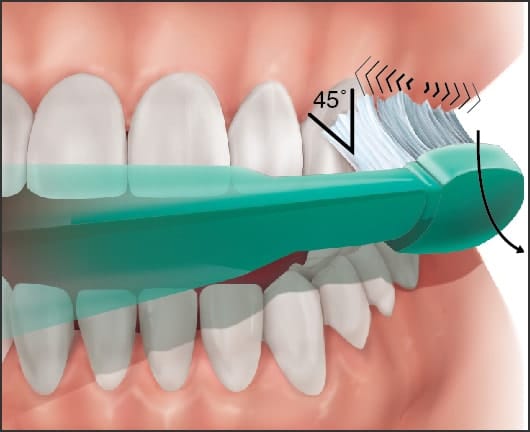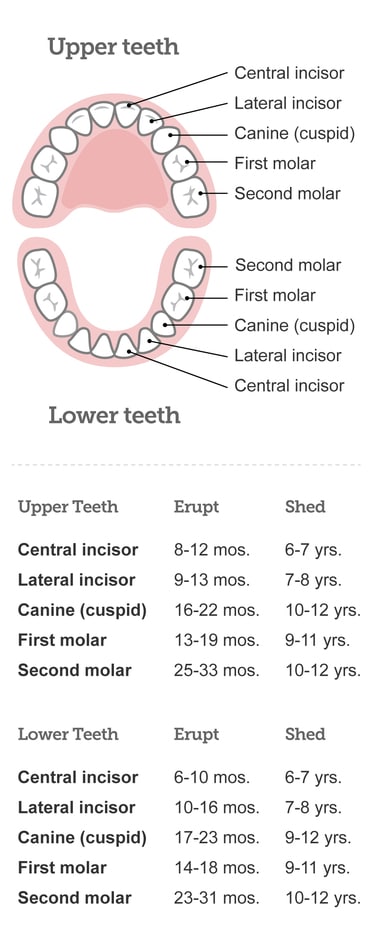Children’s Teeth
How to take care of teeth from birth to age 6!
Your child’s baby teeth are very important!
Baby teeth, also called primary or deciduous teeth, help your child chew and speak normally. They hold space in the jaw for the future adult (permanent) teeth.
Baby teeth start to appear in the mouth generally when the child is 6 months old. By age 3, most children will have the full set of 20 baby teeth.

Baby teeth will be lost as your child grows, but if a baby tooth is lost too early, it may cause issues like crowding when the adult teeth come in.
Adult teeth start to erupt around age 6. By the time children are teenagers, they will usually have all their adult teeth.
The eruption timing above are average times.
Teething Tips
As teeth come in, babies may have sore or tender gums. When your baby is 6 months old, you may want to keep an eye out for signs of teething like irritability, drooling more than usual or chewing or biting on hard items. Gums may sell and your baby may have a harder time sleeping or eating.
To help your baby feel better, you can:
- gently rub you baby’s gum with a clean, wet gauze or towel
- give them a clean, chilled (but not frozen) teething ring
If your baby is still cranky or uncomfortable, please call us or your pediatrician.
First Dental Visit by the First Birthday
The first dental visit should occur after their first tooth appears, but no later than their first birthday.
This first visit is a “well-baby checkup” for your child’s teeth. It’s best to have early preventative visits that we can help you set good habits and practices. Baby teeth can start to decay as soon as they come in. Making sure your child is comfortable, and forms a life long dental home. Emergency visits are much tougher than wellness checks.
Cleaning Baby Teeth
Brushing and cleaning between the teeth are essential for children. Your child should brush 2 times a day for 2 minutes each time. If the teeth are touching, then floss or a floss aid is necessary.
How to brush your child’s teeth:
- Newborn-6 years old: You brush and floss for your child until they are able to write their names legibly.
- 6 years old to 10 years old: Your child can brush independently but they should still be supervised. We recommend you check their brushing and flossing nightly.
As you teach our child how to brush the right way, it may help to stand behind them and hold the brush while they watch in the mirror. Teach them to split out all of the toothpaste after brushing.
Proper Brushing Technique
- Place the toothbrush against the tooth where it meets the gums
- Use a 45-degree angle to make sure you are fully reaching the gum lines as well as the tooth surface.
- Move the brush back and forth gently in short strokes. Brush the outer surface of each tooth. Use the same strokes for the inside surfaces and chewing surfaces of the tooth.

How Much Toothpaste
- Newborn to 2 years old: smear toothpaste on the toothbrush.
- 2 years to 5 years old: use a pea-sized amount of toothpaste.
- 5 years and older: use a regular amount of toothpaste.

Strategies to Prevent Baby Teeth Decay
Sugar left over from food and drink can turn into acid that can attack teeth. The acid can then dissolve the hard outer surface of the tooth, called enamel, which leads to a hole in the tooth.
Breastfeeding: Wipe your baby’s gum with a clean moist gauze pad or washcloth after feedings. Once teeth begin to erupt, pelase be sure to brush their teeth after feedings.
Bottles, Sipping, Snacking: Avoid giving your baby fruit juice (even 100% juice). Limit sugary liquids and sweets to meal times. Never put your child to bed with a bottle of anything other than water. Milk contains lactose sugar which can cause decay.
Pacifiers: Don’t put the pacifier or spoon in your mouth before giving it to your child if you have any decay-causing bacteria in your mouth as they can be passed by saliva. Don’t dip pacifiers or bottles in anything sweet.
Remineralizing Agents
Fluoride is a mineral that is the most effective agent for remineralizing enamel (Kanduti, 2016). If can cause toxicity with systemic exposure (World Health Organization)
Hydroxyapatite is the mineral content that naturally forms teeth and bones and is no available in nano and micro formulations and can also be used to remineralize teeth.

